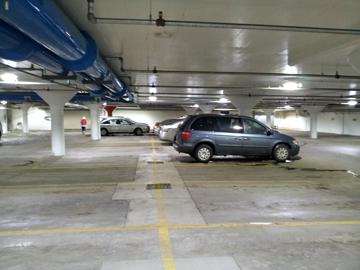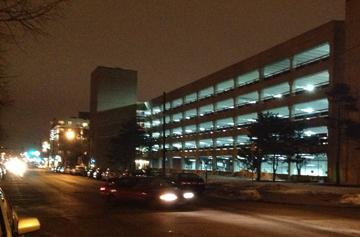Lighting Makes a Difference at the U
Parking and Transportation Services (PTS) supports the University’s sustainability campaign to reach carbon neutrality by 2050. PTS continues adding to the U’s list of energy conservation accomplishments by regularly upgrading and improving infrastructure and technology. Whether it’s in one facility or sixteen facilities, several fixtures or 5,000 fixtures, “It All Adds Up.”
To control energy consumption, the University invested over $3 million between 2012 and 2016 in technology and infrastructure to manage lighting use and utility costs within parking operations. More than 5,000 new lighting fixtures were installed across sixteen facilities. This effort reduced energy consumption by thirty-two percent (32%) and led to international recognition and two lighting awards for Lighting Energy and Efficiency in Parking (LEEP).
How It Began
This project started with a test in the 4th Street Ramp which installed sensors on multiple different light fixture options. The sensors showed that these lights were at full output for less than five percent of the hours in a day. As a result of the test, the University chose LED (light-emitting diode) fixtures that provide light with better color rendering than the older High Pressure Sodium (HPS) light sources. Generally, the white light produced by LEDs results in better user perception than the yellow light of HPS sources. LED fixtures are able to provide a much more uniform distribution of light than traditional fixtures. These new lights are also more directional, allowing for better illumination of surfaces and people. The old HPS fixtures over lit areas immediately below the fixtures in order to have adequate lighting at areas further from the fixtures. This created an overly bright 'hot spot' directly below the old HPS fixtures.
In addition, the new LED light fixtures use much less power to achieve more uniform, better lighting levels than the old fixtures. These lights are proven to be more energy-efficient and significantly reduce long term energy costs while still complying with current lighting industry standards. These LED fixtures are estimated to last 23 years with 24/7 operation at full light output, which also saves on maintenance and replacement costs.
Another aspect of this parking facility upgrade was the addition of two advanced sensor types: daylight-sensing and motion detectors. The daylight-sensing detector analyzes the level of natural light inside above-ground parking structures and turns off lights during the day when adequate natural light exists to meet required lighting standards. Light fixtures more than 60 feet from an opening to daylight continue to operate 24/7. The motion sensor detects vehicle movement and pedestrian activity and dims light fixtures when the parking facility is not occupied. These sensors control light fixtures in large sections or blocks to avoid the strobe light effect of individual fixtures turning on one at a time. For safety and security purposes, light fixtures are dimmed to 25 percent of full light output as opposed to turning completely off.
The first locations that were converted in 2012-13 were Northrop Auditorium Garage, Church Street Garage, and Oak Street Ramp. More parking structures were upgraded from 2014-15, including Nolte Center Garage, 19th and 21st Avenue Ramps, 717 Delaware Garage, 4th Street Ramp and East River Road Garage. The rest of the University parking ramps and garages were completed in 2016.
Investment in technology has enabled the University to manage its utilities more effectively according to demand. During the COVID-19 stay-at-home order, the lighting system automatically operated at lower levels resulting in energy savings and an annualized reduction in more than 500 tons of carbon dioxide emissions.
As our campus evolves, PTS strives to support the University’s vision on sustainability and goal to reduce carbon output. Through partnerships and collaboration with other departments, PTS continues to seek other opportunities to operate more effectively, more efficiently, and more sustainably.
In 2017, PTS upgraded lighting fixtures in more than 30 surface lots to daylight and motion-sensing LED technology to provide better lighting while controlling increasing energy costs. In recent years, PTS worked with Facility Management’s Energy department to update lighting in parking facility lobbies and stair towers. PTS and Energy Management also installed an emergency generator to provide backup power to maintain adequate lighting in the Fourth Street Parking Ramp during electrical outages. In 2020, PTS collaborated with Energy Management to convert the Oak Street Parking Ramp, one of the largest parking facilities on campus, over to the University’s power grid to more effectively and reliably manage the facility’s power supply.
While all these energy savings and controls help boost the U’s conservation efforts, our customers’ personal safety and security is always our number one concern. PTS maintains its pledge of providing safe and convenient access to the University for everyone.


